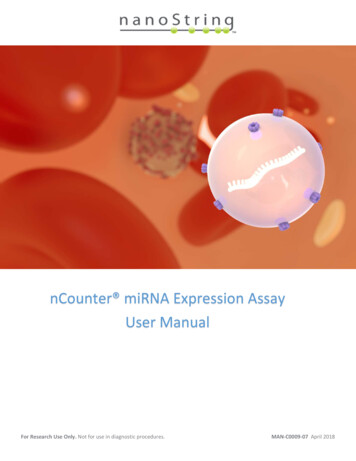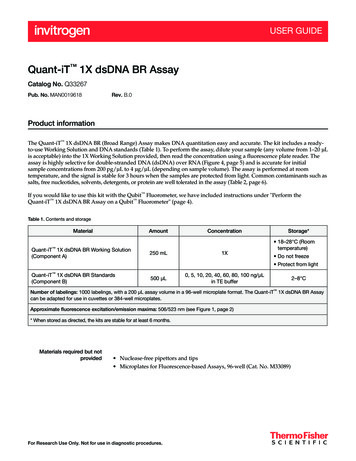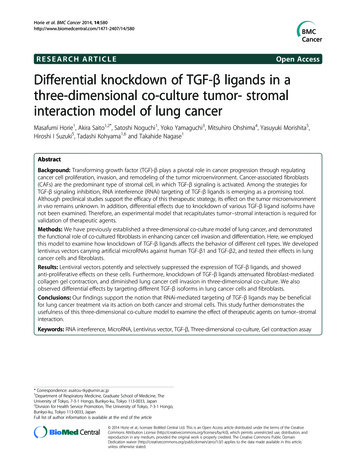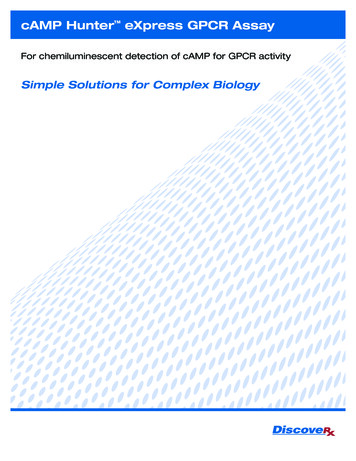
Transcription
nCounter miRNA Expression AssayUser ManualFor Research Use Only. Not for use in diagnostic procedures.MAN-C0009-07 April 2018
nCounter miRNA Expression Assay User ManualMAN-C0009-07ContentsIntroduction .3Product Workflow . 3Overview of miRNA Sample Preparation . 3CodeSet Hybridization and Downstream Processing. 4Materials and Equipment .5Thermal Cycler Guidelines .7Thermal Cycler Protocols . 7Sample Guidelines/Recommendations .8Understanding and Troubleshooting RNA Sample Contamination . 9miRNA Sample Preparation Protocol .10miRNA CodeSet Hybridization Setup Protocol .12Setting Up nCounter Hybridization Assays . 122
nCounter miRNA Expression Assay User ManualMAN-C0009-07IntroductionThe nCounter miRNA Expression Assay is designed to provide an ultra-sensitive, reproducible, and highlymultiplexed method for detecting miRNAs in total RNA across all biological levels of expression. The assayprovides a method for detecting miRNAs without the use of reverse transcription or amplification by usingmolecular barcodes called nCounter Reporter Probes. The assay can be run on total RNA isolated fromany source, including formalin-fixed paraffin embedded (FFPE) samples.This manual describes in detail the methods for both the miRNA Sample Preparation and the miRNACodeSet Hybridization. For instructions on post-hybridization processing and data analysis please see thenCounter Analysis System User Manual (MAN-C0035), nCounter SPRINT Profiler User Manual(MAN-10017), and the Gene Expression Data Analysis Guidelines (MAN-C0011).Product WorkflowTable 1. Workflow for the nCounter miRNA AssayDay 1:ManualProcessingDay 2:AutomatedProcessingProcessHands-on TimemiRNA Sample Preparation Protocol30 minutesmiRNA CodeSet Hybridization Setup Protocol5 minutesProcessHands-on TimeSet up either the Prep Station run or SPRINT run30 minutesMove Cartridge to Digital Analyzer for Data Collection (MAX/FLEX only)5 minutesOverview of miRNA Sample PreparationThe nCounter miRNA Sample Preparation Kit, provided with the miRNA Expression Panels, includesreagents for ligating unique oligonucleotide tags onto miRNAs of interest, allowing these short RNAs tobe detected with great specificity and sensitivity. The miRNA tag ligation reaction can be performed in abackground of total RNA.Sample preparation involves a multiplexed annealing of the specific tags to their target miRNA, a ligationreaction, and an enzymatic purification to remove the unligated tags. Sequence specificity between eachmiRNA and its appropriate tag is ensured by careful, stepwise control of annealing and ligationtemperatures. Control RNA included in the nCounter miRNA Sample Preparation Kit allows the user tomonitor the ligation efficiency and specificity through each step of the reaction.The total hands-on time for the sample preparation reaction is approximately 30 minutes, with an elapsedtime of approximately 2 hours.3
nCounter miRNA Expression Assay User ManualMAN-C0009-07CodeSet Hybridization and Downstream ProcessingNanoString technology is based on the direct molecular barcoding and digital detection of targetmolecules using a color-coded probe pair. The probe pair consists of a Reporter Probe, which carries thesignal on its 5’ end, and a Capture Probe, which carries a biotin on its 3’ end. The complexity of the colorcodes, comprised of four colors in six positions, allows a large diversity of targets present in the samesample to be individually resolved and identified during data collection. During the overnight hybridizationreaction, probe pairs are present in large excess to target nucleic acids to ensure that each target finds aprobe pair.Figure 1. miRNA-specific preparation to utilize the general nCounter technology downstreamThe nCounter miRNA expression assay can be run on either nCounter Analysis system. The MAX/FLEX iscomprised of two instruments, the Prep Station used for post-hybridization processing, and the DigitalAnalyzer used for data collection. The SPRINT Profiler is a single instrument that handles both the posthybridization processing and the data collection together.After hybridization, excess probes are washed away using a two-step magnetic bead-based purification.Magnetic beads derivatized with short nucleic acid sequences that are complementary to the CaptureProbe and the Reporter Probes are used sequentially. First, the hybridization mixture containingtarget/probe complexes is allowed to bind to magnetic beads complementary to sequences on theCapture Probe. Wash steps are performed to remove excess Reporter Probes and non-target cellulartranscripts. After washing, the Capture Probes and target/probe complexes are eluted off the beads andare hybridized to magnetic beads complementary to sequences on the Reporter Probe. An additionalwash is performed to remove excess Capture Probes. Finally, the purified target/probe complexes areeluted off the beads and immobilized on the cartridge for data collection.Digital images are processed and the barcode counts are tabulated in a comma separated value (CSV)format. Data can be analyzed using the nSolver software or other analysis programs.4
nCounter miRNA Expression Assay User ManualMAN-C0009-07Materials and EquipmentTable 2. Materials provided in the nCounter miRNA Assay KitItemReagentsStoragemiRNA CodeSet panel:- Human v3: Catalog # CSO-MIR3-12- Mouse v1.5: Catalog # CSO-MMIR15-12- Rat v1.5: Catalog # CSO-RMIR15-12miRNA Reporter CodeSetmiRNA Capture ProbeSet-80 C-80 CnCounter miRNA Sample Prep Kit:(Sold as part of the miRNA Assay kit, but alsoavailable separately)- Human: Catalog # Hu-MIRTAG-12- Mouse: Catalog # Mu-MIRTAG-12- Rat: Catalog # Rn-MIRTAG-12Annealing BuffermiRNA Tag ReagentPEGLigation BufferLigase-20 C-20 C-20 C-20 C-20 C-20 C-80 CLigation Clean-up EnzymemiRNA Assay ControlsTable 3. Additional materials required (not provided).MaterialRecommended SupplierCatalog numbernCounter Master Kit (for MAX/FLEX users)NanoStringNAA-AKIT-012nCounter SPRINT Reagent Pack (for SPRINT users)NanoStringSPRINT-REAG-KITnCounter SPRINT Cartridge (for SPRINT users)NanoStringSPRINT-CAR-1.0Total RNA Extraction Kit†QIAGEN miRNeasy (or equivalent)VariousDEPC-treated (or RNAse-free) waterVariousVariousPipettes for 0.5–10 μL*Rainin (or equivalent)VariousPipettes for 2.0–20 μL*Rainin (or equivalent)VariousPipettes for 20–200 μLRainin (or equivalent)VariousManual multi-channel pipette for 200 μL*RaininL12-200XLS 12-strip standard tubes*BioexpressT-3034-1Disposable glovesVariousVarious*† Extraction Kit must preserve the small RNA fraction.* Alternative products can be used if they offer similar function and reliability.5
nCounter miRNA Expression Assay User ManualTable 4. Required equipment for use of the miRNA Assay.InstrumentsNanoString nCounter SPRINT, MAX, or FLEX analysis systemSpectrophotometer (NanoDrop Technologies or equivalent)Picofuge with strip tube adaptor (Stratagene or equivalent)Calibrated thermal cycler with a heated lid*DNA Engine Thermocycler (MJ Research/BioRad PTC 200 or equivalent)Fluorometer*** See Thermal Cycler Guidelines below.** NanoString recommends using a Qubit Fluorometer for RNA and DNA quantification.6MAN-C0009-07
nCounter miRNA Expression Assay User ManualMAN-C0009-07Thermal Cycler GuidelinesPlease note that a thermal cycler with a heated lid is required for this protocol. NanoString recommendsusing a model with a programmable heated lid. Models without programmable lids may reach a very hightemperature that causes tubes to melt or deform. However, programmable lids may offer different levelsof control. Ideally, NanoString recommends a thermal cycler with a heated lid that can adjust throughout theprotocol. The heated lid should be set to 5 C greater than the current incubation temperature at anymoment. Some heated lids cannot be assigned a floating temperature. In this situation, program the heatedlid to be 5 C greater than the maximum temperature during the protocol. The heated lid should notexceed 110 C.Thermal Cycler ProtocolsTable 5. Annealing, Ligation, and Purification protocolsProtocolAnnealing ProtocolLigation ProtocolPurification ProtocolTempTime94 C1 min65 C2 min45 C10 min48 CHoldTotal Time13 minutes48 C3 min47 C3 min46 C3 min45 C5 min65 C10 min4 CHoldTotal Time24 minutes37 C1 hour70 C10 min4 CHoldTotal Time1 hour 10 minutes7
nCounter miRNA Expression Assay User ManualMAN-C0009-07Sample Guidelines/RecommendationsThe nCounter miRNA Expression Assay requires purified total RNA as input material. NanoStringrecommends the use of approximately 100 ng of total RNA, as this quantity of input material generatesrobust signal for most tissue and cell isolates. Total RNA purified from any cell or tissue type may be usedin the assay, including formalin-fixed, paraffin-embedded (FFPE) material. Unpurified lysates may not beused with the nCounter miRNA Expression assay, as the denaturants in the homogenization buffer willinhibit the sample preparation reaction.For plasma, serum, or other cell-free sample-derived RNA, please see the Tech Note for nCounter miRNAExpression Analysis in Plasma and Serum Samples for important sample preparation considerations.The quality of the purified RNA is critically important for the nCounter miRNA assay, as residualcontaminants left over from lysis and RNA extraction can impact assay performance by inhibiting theenzymatic ligation and purification steps. Typical lysis or extraction contaminants that can inhibit the assayinclude: Guanidinium Isothiocyanate (lysis buffer) Guanidinium HCl (initial wash buffer) Phenol (organic extraction) Ethanol (secondary wash buffer)Purified RNA quality can be evaluated via a spectrophotometer by measuring absorbance at 230 nm (A230),260 nm (A260) and 280 nm (A280). The A260/A280 ratio can help identify contamination with proteins, whereasthe A260/A230 ratio can help identify contamination with organic compounds, such as phenol, andguanidinium salts. NanoString recommends a 260/280 ratio of 1.9 or greater and a 260/230 ratio of 1.8or greater for optimal results. Please note that for plasma, serum, or other cell-free sample-derived RNA,the mRNA content will be too low to obtain accurate absorbance measurements.8
MAN-C0009-07nCounter miRNA Expression Assay User ManualUnderstanding and Troubleshooting RNA Sample ContaminationSignificant absorbance at 280 nm can indicate contamination with protein. Such contamination may leadto an overestimation of the RNA concentration, resulting in a lower-than-anticipated signal in the assay.Significant absorbance at 230 nm is indicative of contamination with phenol or guanidinium; a “pure” RNAsample should have a A260/A230 ratio above 2.0. Extra washes with a secondary wash buffer or ethanol canhelp to minimize carry-through. It is also important that residual secondary wash buffer be removed priorto elution/resuspension.IMPORTANT: At very low RNA concentrations (under 10 ng/μL), the A260/A230 ratio may be unreliable as anindicator of contamination, due to limited nucleic acid absorbance at 260 nm. For tissue and cellderived RNA, NanoString recommends preparing samples with a concentration of 33 ng/μL,allowing 100 ng of total RNA to be added to the sample preparation reaction in the available 3μL volume. Some RNA extraction protocols suggest that better yield can be achieved by re-eluting thecolumn with the initial eluate. NanoString does not recommend this, as the extra elution cangenerate significant carry through of guanidinium and organic contamination. If re-elution mustbe performed, it should be preceded by at least 2 additional column washes with the secondaryethanol-based wash buffer (for a total of 4 secondary washes). Ethanol is not evident spectrophotometrically, but can be eliminated by a one-minute post-washcentrifugation in a clean collection tube, as is suggested in most kit protocols. Additionally, airdrying the filter for five minutes can help if ethanol contamination persists.9
nCounter miRNA Expression Assay User ManualMAN-C0009-07miRNA Sample Preparation ProtocolnCounter miRNA assays require purified total RNA as input material. See the SampleGuidelines/Recommendations for additional information on sample input considerations.All experiments should be designed in sets of twelve samples. The protocol below is for one set of 12samples. All reagents are supplied in 12-reaction aliquots.1. Prepare a 1:500 dilution of the miRNA Assay Controls. To do this, we recommend 499 μL DEPC H20 to1 μL of the miRNA Assay Controls in a sterile microcentrifuge tube. Mix by vortexing and briefly spindown. Store on ice.2. Prepare an annealing master mix by combining 13 μL of Annealing Buffer, 26 μL of nCounter miRNATag Reagent and 6.5 μL of the 1:500 miRNA Assay Controls dilution prepared in Step 1. Mix well bypipetting up and down.3. Aliquot 3.5 μL of the annealing master mix into each tube of a 12 x 0.2 mL strip tube.4. Add 3 μL maximum of RNA sample to each tube. Cap tubes and flick tubes gently to mix. Spin down.5. Place strip in thermal cycler and initiate Annealing Protocol (Table 5).6. Combine 19.5 μL PEG and 13 μL Ligation Buffer to prepare a ligation master mix.CAUTION: PEG is viscous and should be pipetted slowly to ensure accurate transfer ofvolume into the mix. Mix well by pipetting up and down.7. Following completion of the Annealing Protocol, when the thermal cycler has reached 48 C, add 2.5μL of the ligation master mix to each tube. (Do not turn off the thermal cycler; you will need the blockto be at 48 C in Step 8 and Step 9). Flick tubes gently to mix and spin down.8. Return tubes to 48 C thermal cycler, close lid, and incubate at 48 C for 5 min.WARNING: For Step 9, do not remove tubes from the thermal cycler. Maintaining thetemperature of the tubes at 48 C is critical for optimal assay performance. Tubes shouldnever be removed from heat block during this step.9. Open thermal cycler, carefully remove caps from tubes, leaving strip in place in the heat block, andadd 1.0 μL of Ligase directly to the bottom of each tube while incubating at 48 C. Check the pipettetip to make certain all of the Ligase was added to the reaction. There is no need to mix.NOTE: To keep track of Ligase addition to sequential samples, it can be helpful to line up 12tips in front of thermal cycler, discarding each tip after use.10. Immediately after addition of Ligase to the final tube, recap tubes (leaving tubes in heat block), closethermal cycler, and initiate Ligation Protocol (Table 5).11. After completion of Ligation Protocol, add 1 μL Ligation Clean-Up Enzyme to each reaction. The tubescan be removed from the heat block for this step. Flick tubes gently to mix. Spin down.12. Return tubes to thermal cycler and initiate Purification Protocol (Table 5).10
MAN-C0009-07nCounter miRNA Expression Assay User Manual13. After completion of Purification Protocol, add 40 μL DEPC (or RNAse-free) H2O to each sample. Mixwell and spin down.NOTE: At this stage, purified sample preparation reactions may be stored at –20 C for up toseveral weeks.)14. Proceed with miRNA CodeSet Hybridization Setup Protocol.NOTE: Be sure to denature your samples before proceeding with CodeSet Hybridization(Step 5 of the following protocol).11
nCounter miRNA Expression Assay User ManualMAN-C0009-07miRNA CodeSet Hybridization Setup ProtocolSetting Up nCounter Hybridization AssaysCAUTION: During the setup of your assay, do not vortex or pipet reactions vigorously to mixas it may shear the Reporter Probes. Mixing should be done by flicking or inverting the tubes.Do not spin tubes any faster than 1,000 rpm for more than 30 seconds; do not “pulse”microfuge to spin, as that will cause the centrifuge to go to maximum speed and you mayspin your CodeSet out of solution.The final hybridization reaction will contain the following components: 10 μL Reporter CodeSet, 10 μLhybridization buffer, a 5 μL aliquot from the miRNA Sample Preparation Protocol, and 5 μL CaptureProbeSet. The order of addition of components is important; please follow the protocol exactly.1. Remove aliquots of both the Reporter CodeSet and Capture ProbeSet reagent from the freezer andthaw on ice. Invert the aliquots several times to mix well and briefly spin down reagent at 1000 rpm(see the above CAUTION).IMPORTANT: After it has thawed, inspect the tube of Reporter CodeSet to make sure nocolored precipitate is present. If you see a colored precipitate, heat the entire tube to 75 Cfor 10 minutes and cool at room temperature before using.2. Create a master mix containing 130 μL of the Reporter CodeSet and 130 μL of hybridization buffer byadding the hybridization buffer to the tube containing the Reporter CodeSet. Do not add the CaptureProbeSet to the Master Mix. Invert to mix and spin down master mix.Table 6. Hybridization Master Mix and Reaction ContentsComponentHyb Master Mix (µL)Per Reaction (µL)In tube (130)1013010Sample from the miRNA Sample Preparation Protocol-5miRNA Capture ProbeSet-526030miRNA Reporter CodeSetHybridization BufferTotal Volume3.Label a provided 12-tube strip and cut it in half so it will fit in a picofuge.4. Add 20 μL of master mix to each of the 12 tubes.NOTE: It is advisable to use a fresh tip for each pipetting step to pipet the correct volume.The CodeSet has components that can start to wick up into the tip and not dispense thecorrect amount if you use the same tip to dispense master mix into all of the hybridizationtubes.5. Denature samples from the miRNA sample prep protocol at 85 C for 5 minutes and quick-cool on ice.Add a 5 μL aliquot from the miRNA Sample Preparation Protocol to each tube.12
MAN-C0009-07nCounter miRNA Expression Assay User Manual6. Pre-heat thermal cycler to 65 C. Program the thermal cycler using 30 μL volume, calculatedtemperature, heated lid, and “forever” time setting. Do not set the thermal cycler to ramp down to4 C at the end of the run.NOTE: A thermal cycler with a heated lid is required for this protocol. NanoStringrecommends a thermal cycler with a programmable heated lid. Models withoutprogrammable lids may reach a high temperature that causes tubes to melt or deform duringextended or overnight hybridization times, and if used, should be set to ensure that theheated lid does not exceed 110 C.7. Add 5 μL of Capture ProbeSet to each tube immediately before placing at 65 C. Cap tubes and mix thereagents by inverting the strip tubes several times and flicking with your finger to ensure completemixing. Briefly spin down at 1000 rpm and immediately place the strip tube in the 65 C thermalcycler. Minimizing the time between the addition of the Capture ProbeSet and the placement of thereaction at 65 C will increase the sensitivity of your assay.8. Incubate hybridization assays for at least 12 hours. Hybridizations should be left at 65 C until readyfor processing. Maximum hybridization time should not exceed 30 hours.9. Once removed from the thermal cycler, proceed immediately to post-hybridization processing withthe nCounter Analysis System User Manual (MAN-C0035) or the nCounter SPRINT Profiler User Manual(MAN-10017). Do not store hybridizations at 4 C.13
nCounter miRNA Expression Assay User ManualMAN-C0009-07Intellectual Property RightsThis nCounter miRNA Assay User Manual and its contents are the property of NanoString Technologies, Inc. (“NanoString”), andare intended for the use of NanoString customers solely in connection with their operation of the nCounter Analysis System. ThenCounter Analysis System (including both its software and hardware components) and this User Manual and any otherdocumentation provided to you by NanoString in connection therewith are subject to patents, copyright, trade secret rights, andother intellectual property rights owned by or licensed to NanoString. No part of the software or hardware may be reproduced,transmitted, transcribed, stored in a retrieval system, or translated into other languages without the prior written consent ofNanoString. For a list of applicable patents, see www.nanostring.com/company/patents.Limited LicenseSubject to the terms and conditions of sale of the nCounter Analysis System, NanoString grants you a limited, non-exclusive, nontransferable, non-sublicensable, research use only license to use this proprietary nSolver software with the nCounter AnalysisSystem only in accordance with this manual, the manual for the nCounter Analysis System, and other written instructionsprovided by NanoString. Except as expressly set forth in the terms and conditions, no right or license, whether express, implied,or statutory, is granted by NanoString under any intellectual property right owned by or licensed to NanoString by virtue of thesupply of this software or the proprietary nCounter Analysis System. Without limiting the foregoing, no right or license, whetherexpress, implied, or statutory, is granted by NanoString to use the nSolver Analysis Software or nCounter Analysis System withany third-party product not supplied or licensed to you by NanoString, or recommended for use by NanoString in a manual orother written instruction provided by NanoString.TrademarksNanoString, NanoString Technologies, the NanoString logo, nCounter, and nSolver are trademarks or registered trademarks ofNanoString Technologies, Inc., in the United States and/or other countries. All other trademarks and/or service marks not ownedby NanoString that appear in this document are the property of their respective owners. 2018 NanoString Technologies, Inc. All rights reserved.Contact UsNanoString Technologies, Inc.530 Fairview Ave NSeattle, Washington o@nanostring.com14For Research Use Only. Not for use in diagnostic procedures.
The nCounter miRNA Expression Assay is designed to provide an ultra-sensitive, reproducible, and highly multiplexed method for detecting miRNAs in total RNA across all biological levels of expression. The assay provides a method for detecting miRNAs withou t the use of reverse transcription or amplification by using










